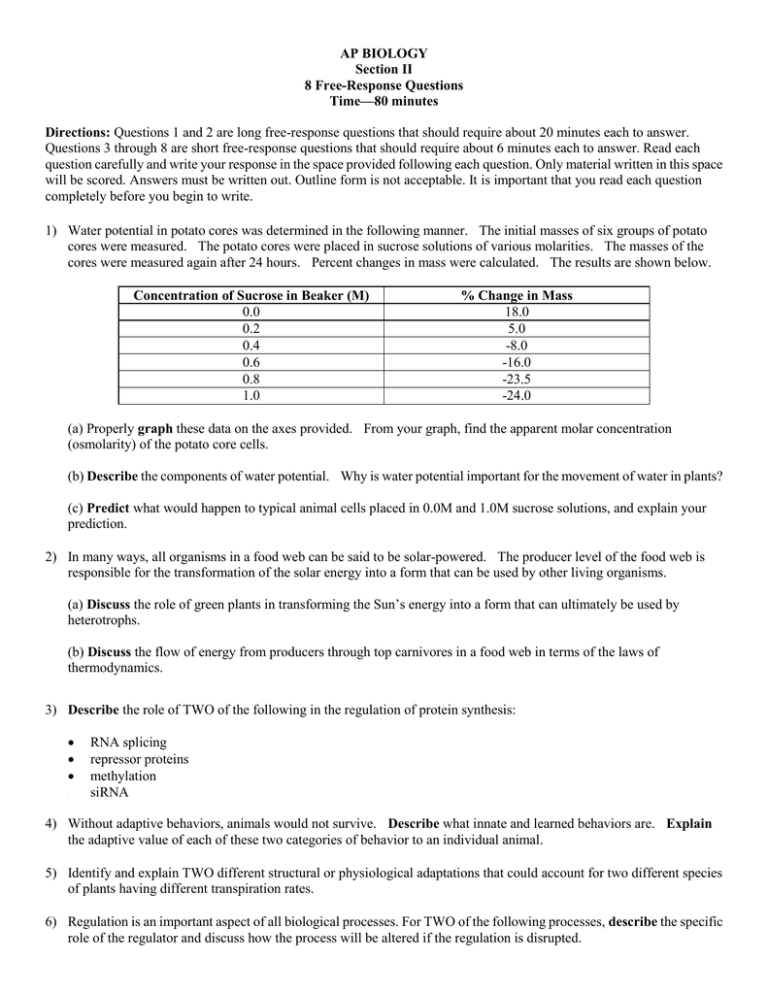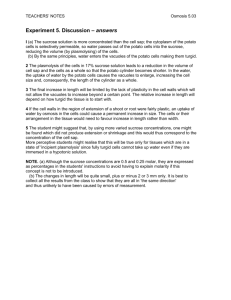AP BIOLOGY Section II 8 Free-Response Questions Time—80 minutes
advertisement

AP BIOLOGY Section II 8 Free-Response Questions Time—80 minutes Directions: Questions 1 and 2 are long free-response questions that should require about 20 minutes each to answer. Questions 3 through 8 are short free-response questions that should require about 6 minutes each to answer. Read each question carefully and write your response in the space provided following each question. Only material written in this space will be scored. Answers must be written out. Outline form is not acceptable. It is important that you read each question completely before you begin to write. 1) Water potential in potato cores was determined in the following manner. The initial masses of six groups of potato cores were measured. The potato cores were placed in sucrose solutions of various molarities. The masses of the cores were measured again after 24 hours. Percent changes in mass were calculated. The results are shown below. Concentration of Sucrose in Beaker (M) 0.0 0.2 0.4 0.6 0.8 1.0 % Change in Mass 18.0 5.0 -8.0 -16.0 -23.5 -24.0 (a) Properly graph these data on the axes provided. From your graph, find the apparent molar concentration (osmolarity) of the potato core cells. (b) Describe the components of water potential. Why is water potential important for the movement of water in plants? (c) Predict what would happen to typical animal cells placed in 0.0M and 1.0M sucrose solutions, and explain your prediction. 2) In many ways, all organisms in a food web can be said to be solar-powered. The producer level of the food web is responsible for the transformation of the solar energy into a form that can be used by other living organisms. (a) Discuss the role of green plants in transforming the Sun’s energy into a form that can ultimately be used by heterotrophs. (b) Discuss the flow of energy from producers through top carnivores in a food web in terms of the laws of thermodynamics. 3) Describe the role of TWO of the following in the regulation of protein synthesis: RNA splicing repressor proteins methylation siRNA 4) Without adaptive behaviors, animals would not survive. Describe what innate and learned behaviors are. Explain the adaptive value of each of these two categories of behavior to an individual animal. 5) Identify and explain TWO different structural or physiological adaptations that could account for two different species of plants having different transpiration rates. 6) Regulation is an important aspect of all biological processes. For TWO of the following processes, describe the specific role of the regulator and discuss how the process will be altered if the regulation is disrupted. Process Cell cycle Metabolic rate Ovarian cycle Prey population dynamics Ecological succession Regulator Cyclin Thyroxine Follicle-stimulating hormone (FSH) Predators fire 7) Discuss how the immune system responds to an initial pathogenic exposure, and how this initial exposure can lead to a quicker response following a second exposure to the same pathogen. 8) Organisms rarely exist alone in the natural environment. The following are five examples of symbiotic relationships. Plant root nodules Digestion of cellulose Epiphytic plants AIDS (acquired immune deficiency syndrome) Anthrax Choose TWO of the above and for each example chosen: (a) identify the participants involved in the symbiosis and describe the symbiosis relationship, and (b) discuss the specific benefit or detriment, if any, that each participant receives from the relationship. AP Biology Big 2 Free Response Questions Answer Section ESSAY 1. 2. SHORT ANSWER 3. 4. One point for each of the following explanations/identifications: - Description of innate behavior - Description or definition of learned behavior (change with experience/trial and error) - Explanation of how innate behavior is adaptive - Explanation of how learned behavior is adaptive. 5. 6. 7. 8.





